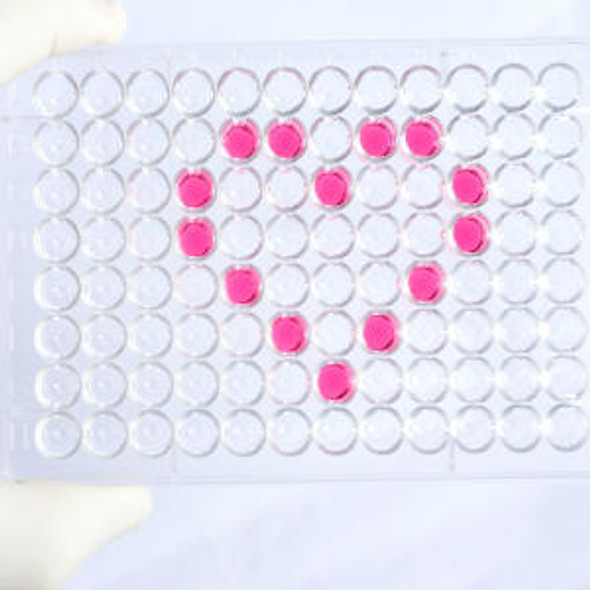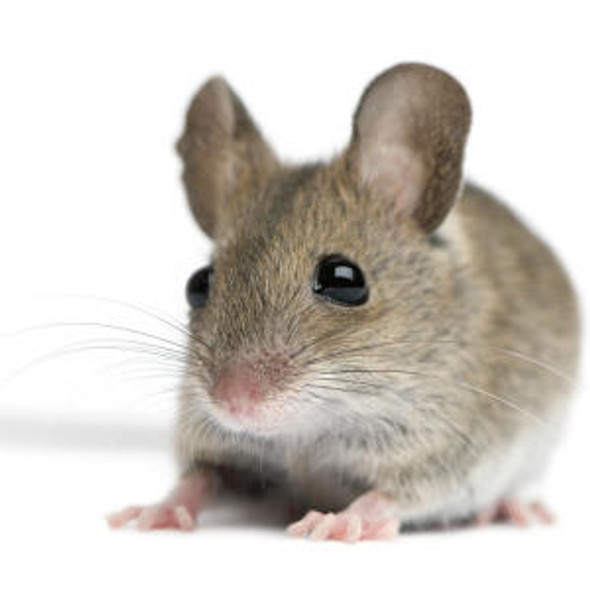Human Cell Biology ELISA Kits 4
Human OCLN (Occludin) CLIA Kit (HUES00631)
- SKU:
- HUES00631
- Product Type:
- ELISA Kit
- ELISA Type:
- CLIA Kit
- Size:
- 96 Assays
- Sensitivity:
- 18.75pg/mL
- Range:
- 31.25-2000pg/mL
- ELISA Type:
- Sandwich
- Synonyms:
- BLCPMG
- Reactivity:
- Human
- Sample Type:
- Serum, plasma and other biological fluids
- Research Area:
- Cell Biology
Description
| Assay type: | Sandwich |
| Format: | 96T |
| Assay time: | 4.5h |
| Reactivity: | Human |
| Detection method: | Chemiluminescence |
| Detection range: | 31.25-2000 pg/mL |
| Sensitivity: | 18.75 pg/mL |
| Sample volume: | 100µL |
| Sample type: | Serum, plasma and other biological fluids |
| Repeatability: | CV < 15% |
| Specificity: | This kit recognizes Human OCLN in samples. No significant cross-reactivity or interference between Human OCLN and analogues was observed. |
This kit uses Sandwich-CLIA as the method. The micro CLIA plate provided in this kit has been pre-coated with an antibody specific to Human OCLN. Standards or samples are added to the appropriate micro CLIA plate wells and combined with the specific antibody. Then a biotinylated detection antibody specific for Human OCLN and Avidin-Horseradish Peroxidase (HRP) conjugate are added to each micro plate well successively and incubated. Free components are washed away. The substrate solution is added to each well. Only those wells that contain Human OCLN, biotinylated detection antibody and Avidin-HRP conjugate will appear fluorescence. The Relative light unit (RLU) value is measured spectrophotometrically by the Chemiluminescence immunoassay analyzer. The RLU value is positively associated with the concentration of Human OCLN. The concentration of Human OCLN in the samples can be calculated by comparing the RLU of the samples to the standard curve.
| UniProt Protein Function: | occludin: May play a role in the formation and regulation of the tight junction (TJ) paracellular permeability barrier. It is able to induce adhesion when expressed in cells lacking tight junctions. Interacts with TJP1/ZO1 and with VAPA. Localized at tight junctions of both epithelial and endothelial cells. Highly expressed in kidney. Not detected in testis. Belongs to the ELL/occludin family. 7 isoforms of the human protein are produced by alternative splicing. |
| UniProt Protein Details: | Protein type:Motility/polarity/chemotaxis; Cell adhesion; Membrane protein, multi-pass; Membrane protein, integral Chromosomal Location of Human Ortholog: 5q13. 1 Cellular Component: tight junction; endocytic vesicle; apicolateral plasma membrane; apical plasma membrane; integral to membrane; plasma membrane; cytoplasmic vesicle; intercellular junction; cytosol; cell junction Molecular Function:thiopurine S-methyltransferase activity; protein domain specific binding; protein binding; structural molecule activity Biological Process: methylation; intercellular junction assembly and maintenance; apoptosis; S-adenosylmethionine metabolic process; protein complex assembly; S-adenosylhomocysteine metabolic process; cell structure disassembly during apoptosis Disease: Band-like Calcification With Simplified Gyration And Polymicrogyria |
| NCBI Summary: | This gene encodes an integral membrane protein that is required for cytokine-induced regulation of the tight junction paracellular permeability barrier. Mutations in this gene are thought to be a cause of band-like calcification with simplified gyration and polymicrogyria (BLC-PMG), an autosomal recessive neurologic disorder that is also known as pseudo-TORCH syndrome. Alternative splicing results in multiple transcript variants. A related pseudogene is present 1. 5 Mb downstream on the q arm of chromosome 5. [provided by RefSeq, Apr 2011] |
| UniProt Code: | Q16625 |
| NCBI GenInfo Identifier: | 3914196 |
| NCBI Gene ID: | 100506658 |
| NCBI Accession: | Q16625. 1 |
| UniProt Secondary Accession: | Q16625,Q5U1V4, Q8N6K1, B5BU70, D2DU64, D2DU65, D2IGC0 D2IGC1, E2CYV9, |
| UniProt Related Accession: | Q16625 |
| Molecular Weight: | 522 |
| NCBI Full Name: | Occludin |
| NCBI Synonym Full Names: | occludin |
| NCBI Official Symbol: | OCLN |
| NCBI Official Synonym Symbols: | BLCPMG; PPP1R115 |
| NCBI Protein Information: | occludin; tight junction protein occludin; phosphatase 1, regulatory subunit 115 |
| UniProt Protein Name: | Occludin |
| Protein Family: | Occludin |
| UniProt Gene Name: | OCLN |
| UniProt Entry Name: | OCLN_HUMAN |
As the RLU values of the standard curve may vary according to the conditions of the actual assay performance (e. g. operator, pipetting technique, washing technique or temperature effects), the operator should establish a standard curve for each test. Typical standard curve and data is provided below for reference only.
| Concentration (pg/mL) | RLU | Average | Corrected |
| 2000 | 55194 56248 | 55721 | 55693 |
| 1000 | 23610 24338 | 23974 | 23946 |
| 500 | 11350 10714 | 11032 | 11004 |
| 250 | 4962 5626 | 5294 | 5266 |
| 125 | 2739 2477 | 2608 | 2580 |
| 62.5 | 1368 1254 | 1311 | 1283 |
| 31.25 | 658 690 | 674 | 646 |
| 0 | 27 29 | 28 | -- |
Precision
Intra-assay Precision (Precision within an assay): 3 samples with low, mid range and high level Human OCLN were tested 20 times on one plate, respectively.
Inter-assay Precision (Precision between assays): 3 samples with low, mid range and high level Human OCLN were tested on 3 different plates, 20 replicates in each plate.
| Intra-assay Precision | Inter-assay Precision | |||||
| Sample | 1 | 2 | 3 | 1 | 2 | 3 |
| n | 20 | 20 | 20 | 20 | 20 | 20 |
| Mean (pg/mL) | 109.15 | 195.21 | 975.23 | 117.29 | 191.99 | 954.49 |
| Standard deviation | 13.07 | 22.16 | 104.84 | 11.71 | 22.31 | 87.81 |
| C V (%) | 11.97 | 11.35 | 10.75 | 9.98 | 11.62 | 9.20 |
Recovery
The recovery of Human OCLN spiked at three different levels in samples throughout the range of the assay was evaluated in various matrices.
| Sample Type | Range (%) | Average Recovery (%) |
| Serum (n=5) | 93-108 | 101 |
| EDTA plasma (n=5) | 90-105 | 96 |
| Cell culture media (n=5) | 99-112 | 104 |
Linearity
Samples were spiked with high concentrations of Human OCLN and diluted with Reference Standard & Sample Diluent to produce samples with values within the range of the assay.
| Serum (n=5) | EDTA plasma (n=5) | Cell culture media (n=5) | ||
| 1:2 | Range (%) | 101-119 | 97-112 | 91-101 |
| Average (%) | 109 | 103 | 96 | |
| 1:4 | Range (%) | 103-119 | 98-114 | 88-99 |
| Average (%) | 109 | 106 | 93 | |
| 1:8 | Range (%) | 97-113 | 85-99 | 89-102 |
| Average (%) | 104 | 90 | 95 | |
| 1:16 | Range (%) | 99-117 | 85-99 | 90-104 |
| Average (%) | 107 | 91 | 96 |
An unopened kit can be stored at 4°C for 1 month. If the kit is not used within 1 month, store the items separately according to the following conditions once the kit is received.
| Item | Specifications | Storage |
| Micro CLIA Plate(Dismountable) | 8 wells ×12 strips | -20°C, 6 months |
| Reference Standard | 2 vials | |
| Concentrated Biotinylated Detection Ab (100×) | 1 vial, 120 µL | |
| Concentrated HRP Conjugate (100×) | 1 vial, 120 µL | -20°C(shading light), 6 months |
| Reference Standard & Sample Diluent | 1 vial, 20 mL | 4°C, 6 months |
| Biotinylated Detection Ab Diluent | 1 vial, 14 mL | |
| HRP Conjugate Diluent | 1 vial, 14 mL | |
| Concentrated Wash Buffer (25×) | 1 vial, 30 mL | |
| Substrate Reagent A | 1 vial, 5 mL | 4°C (shading light) |
| Substrate Reagent B | 1 vial, 5 mL | 4°C (shading light) |
| Plate Sealer | 5 pieces | |
| Product Description | 1 copy | |
| Certificate of Analysis | 1 copy |
- Set standard, test sample and control (zero) wells on the pre-coated plate and record theirpositions. It is recommended to measure each standard and sample in duplicate. Note: addall solutions to the bottom of the plate wells while avoiding contact with the well walls. Ensuresolutions do not foam when adding to the wells.
- Aliquot 100µl of standard solutions into the standard wells.
- Add 100µl of Sample / Standard dilution buffer into the control (zero) well.
- Add 100µl of properly diluted sample (serum, plasma, tissue homogenates and otherbiological fluids. ) into test sample wells.
- Cover the plate with the sealer provided in the kit and incubate for 90 min at 37°C.
- Aspirate the liquid from each well, do not wash. Immediately add 100µL of BiotinylatedDetection Ab working solution to each well. Cover the plate with a plate seal and gently mix. Incubate for 1 hour at 37°C.
- Aspirate or decant the solution from the plate and add 350µL of wash buffer to each welland incubate for 1-2 minutes at room temperature. Aspirate the solution from each well andclap the plate on absorbent filter paper to dry. Repeat this process 3 times. Note: a microplatewasher can be used in this step and other wash steps.
- Add 100µL of HRP Conjugate working solution to each well. Cover with a plate seal andincubate for 30 min at 37°C.
- Aspirate or decant the solution from each well. Repeat the wash process for five times asconducted in step 7.
- Add 100µL of Substrate mixture solution to each well. Cover with a new plate seal andincubate for no more than 5 min at 37°C. Protect the plate from light.
- Determine the RLU value of each well immediately.






